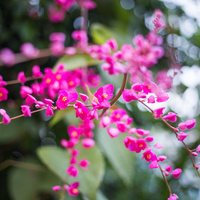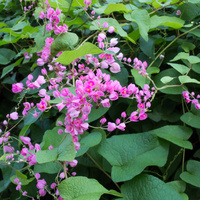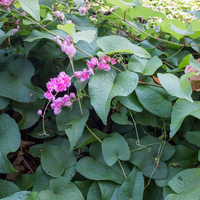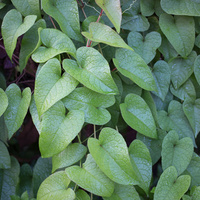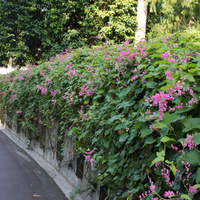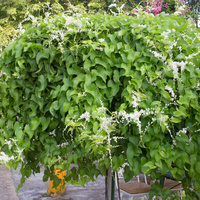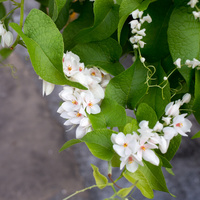Common name: Mexican creeper
Other common names: Bride's tears, Chain of love, Confederate vine, Coralita, Coral vine, Mountain rose, Queen's wreath
Description
A native of Mexico and Guatemala, this flowering vine grows fast and vigorous, using tendrils to cling to and climb up structures it makes contact with.
Individual vines may attain lengths of up to 16 m (53 ft), though they are more commonly 5 to 10 m (16 to 33 ft) long.
Leaves heart-shaped, deep green and alternately arranged along the stems. They fall from the vine during the dry season but will remain on the plant if watered during that time.
The flowers are pink or white, depending on the variety, borne in branched clusters that bloom for several weeks during the year's warmer months, usually from early summer until early winter.
The fruit is a small nut enclosed in a papery capsule and are green when young, becoming brown and brittle when mature.
Use
Mexican creeper is cultivated as an ornamental vine to climb up, on and over fences, walls, pagodas and arbours to cover them and create a showy display of foliage and flowers. Although recommended for planting around swimming pools, the flowers produce nectar that attracts bees in large numbers.
The flowers are reported as a major source of nectar for honeybees in Brazil, India and Malaysia and as a moderate to minor source in Colombia, Cuba, Mexico and the southern United States. They are also a good source of pollen for brood-rearing. And the plant's long flowering habit helps honeybees maintain and build their colonies. The pure honey is variable in colour, from light to dark amber, slow to granulate and has a strong aroma and taste described as similar to molasses with a tang.
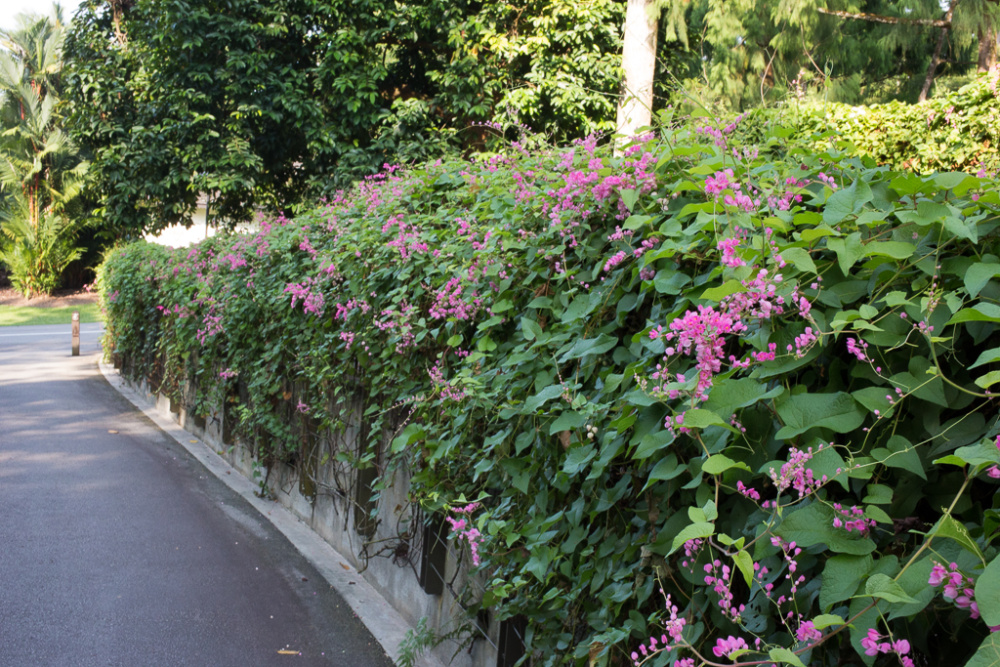
Used as a wall cover (Singapore)
Climate
Mexican creeper grows naturally in sub-humid to moderately humid subtropical and tropical lowland to mid-elevation climates, generally frost-free areas with annual lows of 12 to 25°C, annual highs of 20 to 35°C, annual rainfall of 600 to 4500 mm and a dry season of 7 months or less, extending to 12 months with irrigation.
Growing
New plants are easily grown from cuttings or seed. However, the seed of the white-flowering variety does not come true-to-type, which suggests it is a hybrid and best propagated vegetatively.
Plants perform best on free-draining neutral to alkaline (or limestone) soils, generally with soil pH 7 to 8.5, and on sites with full to partial sun exposure.
Regular weeding and watering help the plant establish. After that, cutting back new growth after flowering helps contains the plant to where intended and stop it from spreading. It has good tolerance to drought but low tolerance to permanently wet soils or salt spray.
Problem features
It is reported as a major weed in more than one country and classed as an invasive species in Australia, a term applied to the most serious weeds of agriculture and the environment. The Hawaii Pacific Weed Risk Assessment project (HPWRA) assessed it as a high weed risk species for Hawaii. Plants usually escape cultivation assisted by animals that eat the fruit and disperse the seed and by people who dump excess or unwanted plant material.
It has a smothering habit, overgrowing shrubs and even large trees, restricting their access to sunlight, eventually killing them.
Where it grows
References
Books
-
Adams, C. D. 1972, Flowering plants of Jamaica, University of the West Indies, Mona, Greater Kingston
-
Bannochie, Iris, 1993. Gardening in the Caribbean. 1 Edition. Macmillan.
-
Bradbear, N. 2009, Bees and their role in forest livelihoods : a guide to the services provided by bees and the sustainable harvesting, processing and marketing of their products, Food and Agriculture Organization of the United Nations (FAO), Rome
-
Cassidy, F. G. & Le Page, R. B. 1980, Dictionary of Jamaican English, 2nd ed., Cambridge University Press, Cambridgeshire
-
Chaplin, L. T. & Brandies M. M. 1998, The Florida Gardener's Book of Lists, Taylor Publishing Company, Dallas, Texas
-
Crane, E., Walker, P. & Day, R. 1984, Directory of important world honey sources, International Bee Research Association, London
-
Griffiths, M. & Burras, J. K. 1994, Manual of climbers and wall plants, Royal Horticultural Society (Great Britain), Timber Press, Portland, Oregon
-
Krohn-Ching, Val 1980, Hawaii dye plants and dye recipes, University Press of Hawaii, Honolulu
-
Macmillan, H. F. 1943, Tropical planting and gardening : with special reference to Ceylon, 5th ed, Macmillan Publishing, London
-
Menninger, E. A. 1970, Flowering vines of the world : an encyclopedia of climbing plants, Hearthside Press, New York
-
Oakman, H. 1995, Harry Oakman's what flowers when : the complete guide to flowering times in tropical and subtropical gardens, University of Queensland Press, St. Lucia, Queensland
-
Perry, B. 2010, Landscape plants for California gardens: an illustrated reference of plants for California landscapes, Land Design Publishing, Claremont, California
-
Perry, F. & Hay, R. 1982, A field guide to tropical and subtropical plants, Van Nostrand Reinhold Company, New York
-
Rauch, F. D. & Weissich, P. R. 2000, Plants for tropical landscapes : a gardener's guide, University of Hawaii Press, Honolulu
-
The Garden Section of the Woman's Club of Havana 1958, Flowering plants from Cuban gardens : Plantas floridas de los jardines cubanos, Criterion Books, New York
Articles, Journals, Reports and Working Papers
-
Morton, J.F. 1964, Honeybee Plants of South Florida, Proceedings of the Florida State Horticultural Society, Vol 77:415-436.
